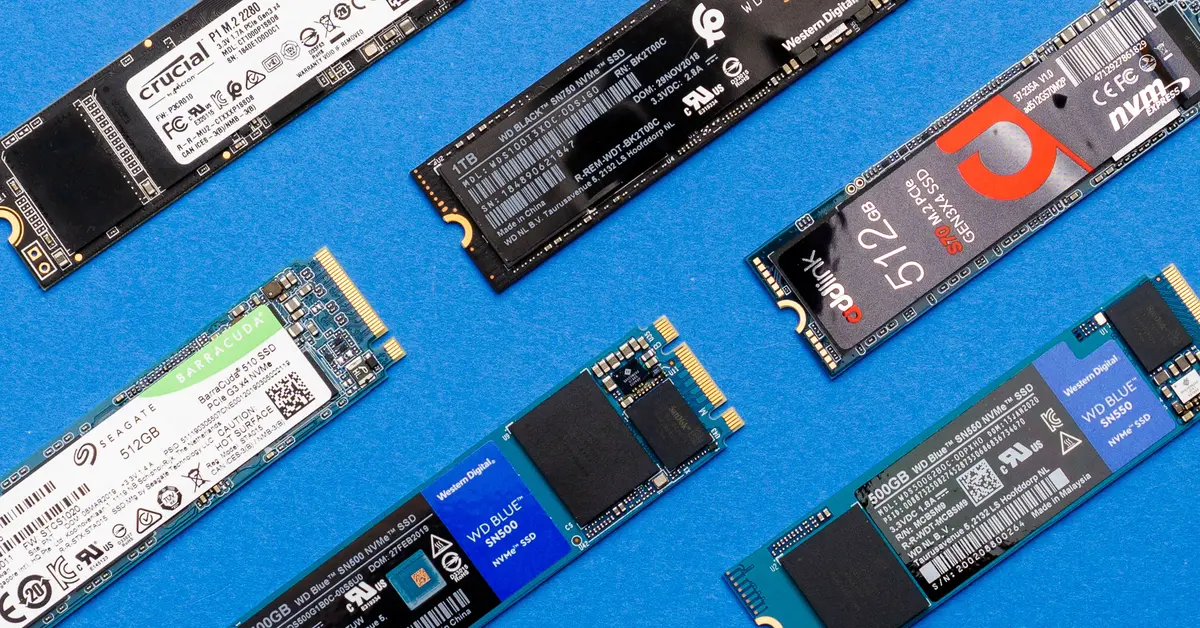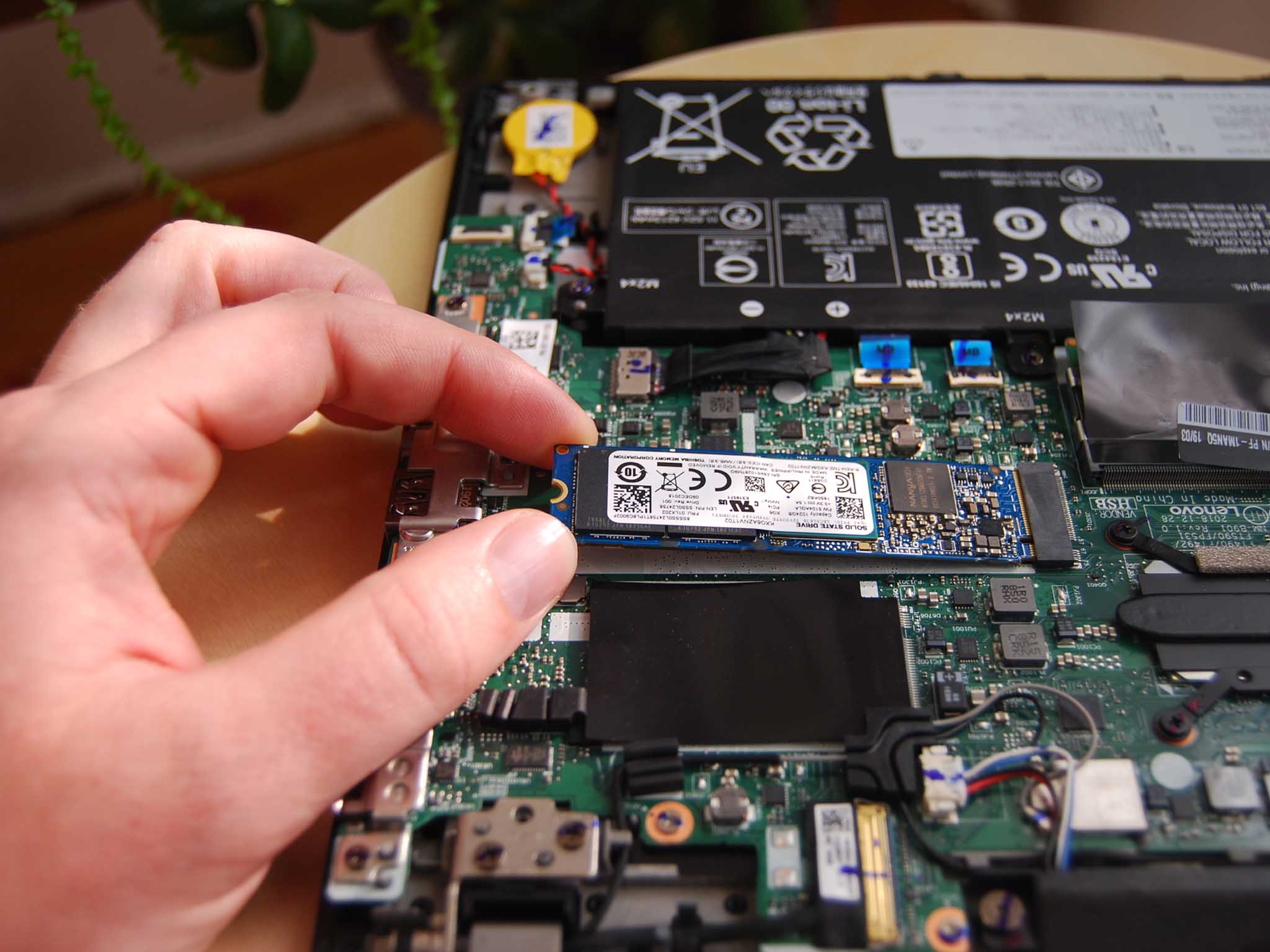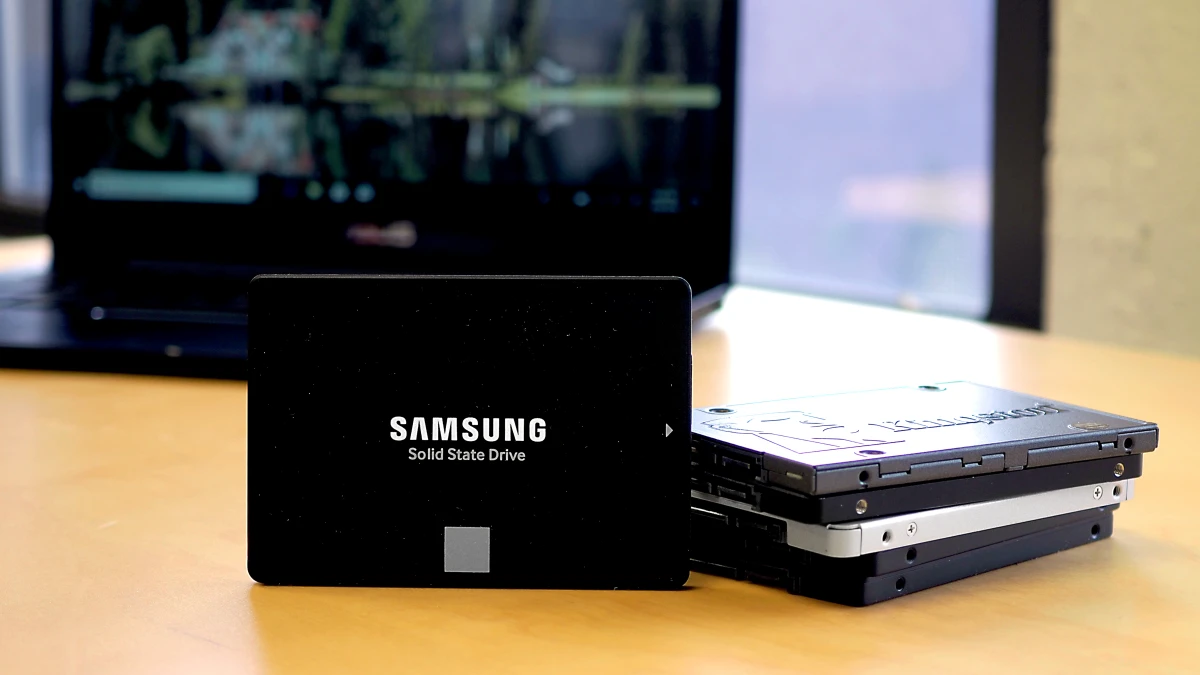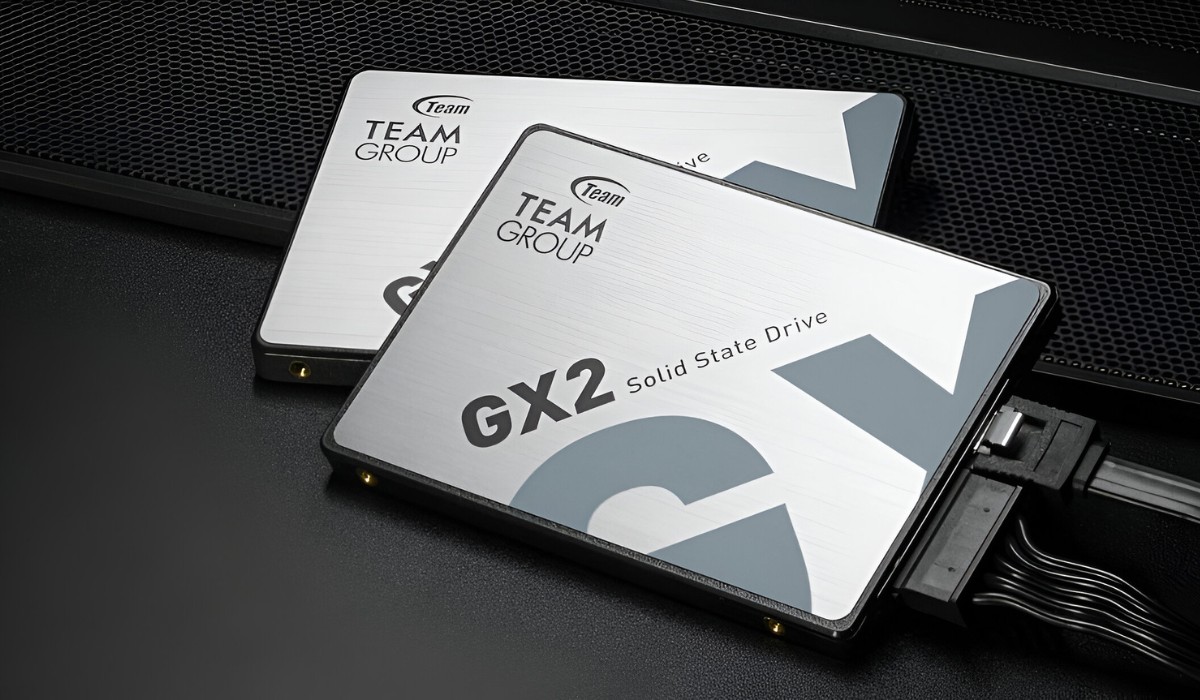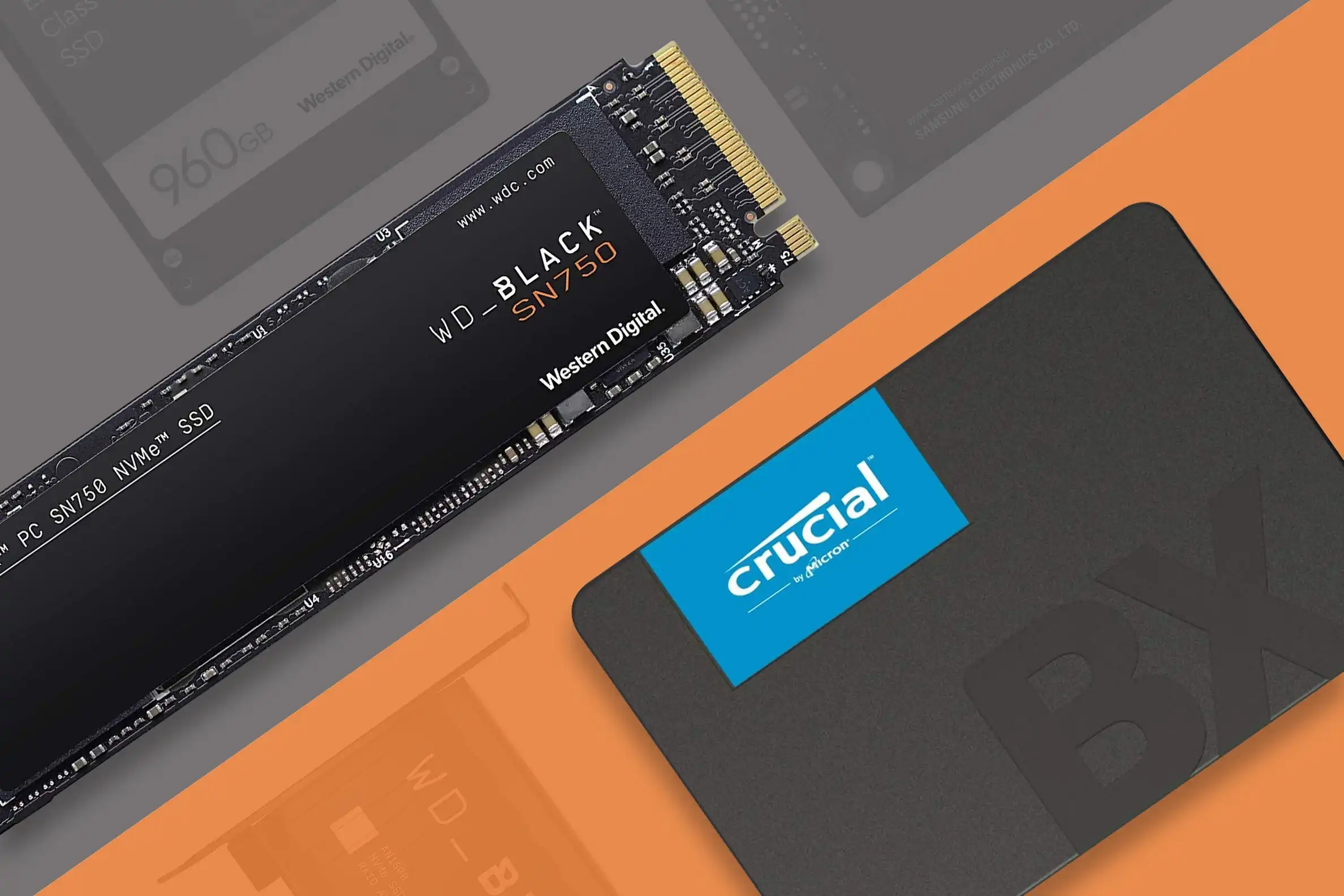Introduction
Welcome to our guide on choosing the best SSD for your laptop!
In today’s digital age, where speed and performance are essential, solid-state drives (SSDs) have revolutionized the storage industry. Gone are the days of slow-loading applications and sluggish boot times. With an SSD, your laptop will experience lightning-fast performance, quick file transfers, and improved overall productivity.
But what exactly is an SSD? How does it differ from a traditional hard drive? And why should you consider upgrading to an SSD for your laptop? In this comprehensive guide, we will explore the world of SSDs and provide you with the essential information you need to make an informed decision.
Unlike traditional hard drives, which use spinning magnetic disks and mechanical parts to store and retrieve data, SSDs are entirely built using flash memory technology. This means that there are no moving parts involved, resulting in faster data access, decreased power consumption, and increased reliability.
So, why should you consider upgrading to an SSD for your laptop? The benefits are many. Firstly, an SSD can significantly improve your laptop’s overall speed and performance. Applications will launch in a blink of an eye, and your laptop will boot up faster than ever before. With no moving parts, SSDs also provide better data protection, as they are less susceptible to physical damage caused by drops or bumps.
Furthermore, SSDs use less power than traditional hard drives, resulting in improved battery life. This is especially beneficial for laptop users who are constantly on the go and rely on their devices for extended periods.
When it comes to choosing an SSD for your laptop, there are a few important factors to consider. The interface type, such as SATA, M.2, or NVMe, will determine the compatibility and performance of the SSD. Additionally, the storage capacity, read/write speeds, and brand reputation are all essential considerations.
In the following sections, we will delve deeper into each of these topics, comparing different SSD types, discussing top brands, and recommending specific SSD options for various laptop uses. We will also provide a step-by-step guide on how to install an SSD in your laptop.
By the end of this guide, you will have all the necessary knowledge to confidently choose the best SSD for your laptop, leading to improved performance and an enhanced computing experience.
What is an SSD?
If you’re new to the world of computer storage, you might be wondering what exactly is an SSD and how it differs from a traditional hard drive. Well, let’s break it down.
SSD stands for Solid-State Drive. Unlike traditional hard drives, which use spinning magnetic disks and mechanical parts to store and retrieve data, SSDs are built using flash memory technology. They consist of a collection of memory chips that retain data even when the power is turned off.
The absence of moving parts in SSDs is their key differentiating factor. Unlike hard drives, which rely on a spinning disk and read/write heads to access data, SSDs have no mechanical components. Instead, they use integrated circuits to store and retrieve data electronically, resulting in much faster read and write speeds.
Speed is where SSDs really shine. Traditional hard drives have to physically locate the data on the spinning disk, which can take time. In contrast, an SSD can access any data location instantly, resulting in significantly faster file transfers, quicker application launches, and speedier boot times for your laptop.
Another advantage of SSDs is their durability. With no moving parts, SSDs are less prone to physical damage caused by drops or bumps. Traditional hard drives, on the other hand, are more vulnerable to failure if subjected to sudden movements or shocks. This makes SSDs a more reliable option, particularly for portable devices like laptops.
Additionally, SSDs consume less power than traditional hard drives. Since they don’t have to spin up a disk or move mechanical parts, SSDs require less energy to operate. This translates to better battery life for your laptop, which is especially beneficial if you’re frequently on the move or don’t have access to a power source for extended periods.
Overall, the combination of speed, durability, and power efficiency makes SSDs a highly desirable storage option for laptops and other computing devices. While they may be slightly more expensive than traditional hard drives when comparing storage capacity, the benefits they offer are well worth the investment.
In the next section, we will explore the various benefits of using an SSD in a laptop and why you should consider upgrading from a traditional hard drive.
Benefits of using an SSD in a laptop
Upgrading your laptop with an SSD can bring a wide range of benefits that significantly improve your computing experience. Let’s explore some of the key advantages of using an SSD in a laptop:
1. Improved Speed and Performance: One of the most noticeable benefits of an SSD is the dramatic improvement in speed and performance. With faster read and write speeds, applications load quicker, files transfer faster, and your overall system responsiveness is greatly enhanced. This means less waiting and more productivity.
2. Faster Boot Times: Say goodbye to long boot-up times with an SSD. Your laptop will start up in seconds rather than minutes, allowing you to get straight to work without any unnecessary delays. Whether you’re preparing for a business meeting or eager to jump into your favorite game, an SSD will get you up and running in no time.
3. Reduced File Access and Load Times: Searching for files, opening documents, or loading large multimedia files can be time-consuming on a traditional hard drive. An SSD significantly reduces file access and load times, enabling you to access your important data swiftly and efficiently. This is particularly beneficial for creative professionals who work with large files such as high-resolution images, videos, or complex design projects.
4. Enhanced Reliability and Durability: With no moving parts, SSDs are more resistant to physical shock and damage compared to traditional hard drives. This makes them ideal for laptops that are frequently transported or used in various environments. You can rest assured knowing that your data is securely stored and protected, even in the event of accidental drops or bumps.
5. Improved Battery Life: SSDs are more power-efficient than traditional hard drives, as they consume less energy. This directly translates into improved battery life for your laptop. Whether you’re working on the go or enjoying an extended gaming session, an SSD will help your laptop last longer without needing to be plugged in.
6. Noiseless Operation: Traditional hard drives produce noticeable noise due to their mechanical components, such as spinning disks and read/write heads. In contrast, SSDs operate silently, providing you with a quiet and peaceful working environment. This makes them ideal for situations where noise reduction is desired, such as working in a library or during conference calls.
7. Compact and Lightweight: SSDs are typically smaller and lighter than traditional hard drives, making them a perfect fit for slim laptops and ultrabooks. The compact form factor allows for greater portability without compromising on storage capacity or performance.
Overall, upgrading your laptop with an SSD will transform your computing experience by delivering faster speeds, improved reliability, longer battery life, and a more efficient workflow. The benefits of an SSD far outweigh the initial investment, making it a worthwhile upgrade for anyone looking to boost the performance of their laptop.
Now that we’ve explored the benefits of using an SSD in a laptop, let’s delve into the factors to consider when choosing the right SSD for your specific needs.
Factors to consider when choosing an SSD for a laptop
Choosing the right SSD for your laptop requires careful consideration of several key factors. Let’s take a closer look at the important aspects to keep in mind when making your decision:
1. Compatibility: Before purchasing an SSD, you need to ensure it is compatible with your laptop. Check the compatibility requirements, such as the interface type (SATA, M.2, NVMe) and physical dimensions to ensure a proper fit. Some laptops may only support specific SSD types, so it’s crucial to verify compatibility before making a purchase.
2. Storage Capacity: Determine the storage capacity you require based on your usage needs. SSDs come in various capacities, ranging from 128GB to several terabytes. Consider the types and sizes of files you frequently work with to determine the appropriate capacity. Keep in mind that larger capacities often come with a higher price tag, so choose the capacity that strikes the right balance between your storage needs and budget.
3. Read/Write Speeds: The read and write speeds of an SSD determine how quickly data can be accessed and transferred. Faster speeds result in snappier performance. Look for SSDs with high sequential read and write speeds, measured in megabytes per second (MB/s), for optimal performance. However, it’s important to note that real-world performance may vary based on other factors such as the laptop’s internal chipset and software optimizations.
4. Brand Reputation: It’s advisable to choose an SSD from a reputable brand known for their quality and reliability. Brands like Samsung, Western Digital, Crucial, and Kingston have a proven track record of producing reliable and high-performing SSDs. Reading reviews and researching the brand’s reputation can provide valuable insights into the quality and customer satisfaction of their products.
5. Endurance and Lifespan: SSDs have a limited number of write cycles before they start to degrade. This is known as the endurance or lifespan of the SSD. Higher-endurance SSDs are usually more expensive but can withstand more write cycles, making them suitable for heavy workloads or uses that involve frequent data writes. Consider your usage patterns and workload to determine the necessary endurance level for your SSD.
6. Price: While SSDs have become more affordable over the years, they still tend to be more expensive than traditional hard drives when comparing storage capacity. Set a budget based on your requirements and determine the best balance between price and performance. Consider opting for a slightly higher-priced SSD that offers better performance and reliability if it fits within your budget.
7. Warranty and Customer Support: Check the warranty and customer support offered by the SSD manufacturer. A longer warranty period indicates the manufacturer’s confidence in their product’s reliability. Additionally, good customer support can be essential in case you encounter any issues or require assistance during the installation or setup process.
By considering these factors, you can ensure that you select an SSD that perfectly matches your laptop’s needs, providing you with the best performance, reliability, and value for your investment.
Now that we’ve explored the important factors to consider when choosing an SSD, let’s move on to comparing the different types of SSDs available for laptops.
Comparison of different SSD types (SATA, M.2, NVMe)
When it comes to choosing an SSD for your laptop, you’ll encounter different types, each with its own advantages and considerations. Let’s compare the three main types of SSDs: SATA, M.2, and NVMe.
SATA SSDs: SATA (Serial ATA) SSDs are the most common and widely compatible type of SSD. They connect to the laptop’s motherboard using the same SATA interface used by traditional hard drives. SATA SSDs offer significant performance improvements over traditional hard drives but are limited by the characteristics of the SATA interface itself. They typically have sequential read and write speeds of around 500MB/s, making them suitable for most everyday computing tasks. SATA SSDs are available in both 2.5-inch form factor, which is compatible with most laptops, and smaller M.2 form factor.
M.2 SSDs: M.2 SSDs are a newer form factor that is becoming increasingly popular for laptops. They are smaller than 2.5-inch drives and connect directly to the motherboard via the M.2 slot. M.2 SSDs come in different lengths, such as 2242, 2260, and 2280, which correspond to the physical dimensions of the SSD. M.2 SSDs can utilize either the SATA or NVMe interface. While SATA-based M.2 SSDs provide similar performance to traditional SATA SSDs, NVMe-based M.2 SSDs offer significantly faster speeds. NVMe-based M.2 SSDs can achieve sequential read and write speeds of over 3000MB/s, making them ideal for demanding tasks such as video editing, gaming, and 3D rendering.
NVMe SSDs: NVMe (Non-Volatile Memory Express) SSDs are the fastest and most advanced form of SSDs currently available. They utilize the PCIe (Peripheral Component Interconnect Express) interface, which offers higher bandwidth and lower latency compared to SATA and M.2 interfaces. NVMe SSDs deliver unparalleled performance, with sequential read and write speeds exceeding 3000MB/s, and random read and write speeds that outperform SATA and M.2 SSDs. NVMe SSDs are especially suited for professionals who work with large datasets, need fast data access, or require high-performance storage for intensive workloads.
When choosing between these SSD types, consider factors such as your laptop’s compatibility, your budget, and your specific performance needs. SATA SSDs are affordable and offer a significant performance boost compared to traditional hard drives. M.2 SSDs, whether SATA or NVMe-based, provide a compact form factor and faster speeds, but compatibility depends on the availability of the M.2 slot on your laptop’s motherboard. NVMe SSDs offer the fastest speeds, making them ideal for professionals seeking maximum performance, but they tend to be more expensive.
Now that you understand the key differences between SATA, M.2, and NVMe SSDs, let’s move on to exploring some of the top SSD brands that you can rely on for your laptop.
Top SSD brands for laptops
When it comes to choosing the best SSD for your laptop, opting for a reputable brand is crucial to ensure performance, reliability, and customer satisfaction. Let’s take a look at some of the top SSD brands that you can trust for your laptop’s storage needs:
1. Samsung: Samsung is a well-known and highly regarded brand in the SSD market. They offer a wide range of SSDs, including SATA, M.2, and NVMe options. Samsung SSDs are known for their excellent performance, reliability, and endurance. With their innovative technologies like TurboWrite and V-NAND, Samsung SSDs consistently deliver high speeds and provide a long-lasting storage solution for your laptop.
2. Western Digital: Western Digital is another prominent brand that offers reliable and high-performance SSDs. They have a diverse lineup, including SATA and NVMe SSDs. Western Digital SSDs are known for their durability, advanced error correction, and power efficiency. With their Western Digital Blue and Black series, they provide dependable SSD options for various laptop uses and budgets.
3. Crucial: Crucial, a brand owned by Micron Technology, is known for producing quality SSDs with excellent performance and reliability. They offer a variety of SATA, M.2, and NVMe SSDs, catering to different laptop needs. Crucial SSDs are highly regarded for their affordability, solid performance, and good endurance, making them a popular choice among budget-conscious users.
4. Kingston: Kingston is a well-established brand in the storage industry, offering a wide array of SSDs for laptops. They have a range of SATA, M.2, and NVMe SSDs that provide reliable performance and excellent value for money. Kingston SSDs are known for their durability, compatibility, and customer satisfaction, making them a popular choice for both casual users and professionals.
5. Adata: Adata is a brand that has gained recognition for its SSDs’ performance, quality, and affordability. They offer a diverse range of SATA, M.2, and NVMe SSDs that deliver solid performance and reliability. Adata SSDs often provide a good balance between price and performance, making them a popular choice for users looking for cost-effective storage solutions.
While these are some of the top SSD brands for laptops, it’s essential to research specific models and read customer reviews to determine the best SSD for your individual needs. Additionally, keep in mind that individual experiences may vary, and it’s always recommended to check the warranty and customer support offered by the SSD manufacturer.
Now that you are familiar with the top SSD brands, let’s move on to the next section, where we will recommend specific SSD options for different laptop uses.
Recommended SSD options for different laptop uses (gaming, creative work, everyday use)
Choosing the right SSD for your laptop depends on your specific needs and usage requirements. Whether you’re a gamer, a creative professional, or an everyday user, here are some recommended SSD options for different laptop uses:
For Gaming:
Gamers require fast storage to ensure smooth gameplay, quick loading times, and reduced lag. Here are a few SSD options suitable for gaming laptops:
– Samsung 970 EVO Plus: This NVMe M.2 SSD offers blazing-fast sequential read and write speeds, making it perfect for gaming. It provides exceptional performance, reliability, and high endurance.
– Western Digital WD Black SN750: Another NVMe M.2 SSD designed for gaming enthusiasts. It offers high-speed performance, low latency, and comes in various capacities to suit different gaming needs.
For Creative Work:
Creative professionals, such as photographers, video editors, and graphic designers, require storage solutions that can handle large file sizes and demanding applications. Here are some recommended SSD options for creative work:
– Crucial MX500: This SATA SSD offers a good balance of performance, reliability, and affordability. It provides ample storage capacity, efficient data transfer speeds, and is ideal for storing and working with large multimedia files.
– Samsung 980 PRO: This high-performance NVMe M.2 SSD is perfect for professionals who need blazing-fast speeds. With its impressive sequential read and write speeds, it can handle resource-intensive tasks such as video editing and 3D rendering with ease.
For Everyday Use:
If you use your laptop for general tasks like web browsing, document editing, and media consumption, an SSD that offers a good balance between performance and affordability is recommended. Here are a couple of options suitable for everyday use:
– Kingston A2000: This NVMe M.2 SSD provides fast performance and reliability at an affordable price. It offers excellent value for money and is suitable for everyday computing tasks.
– Adata SU800: This SATA SSD is known for its affordable price and reliable performance. It offers good storage capacity, quick data transfer speeds, and is suitable for casual users who prioritize a budget-friendly option.
While these are some recommended SSD options for specific laptop uses, it’s important to consider your budget, storage requirements, and other factors before making a final decision. Always check the compatibility of the SSD with your laptop and read customer reviews to ensure it meets your specific needs.
In the next section, we will provide a step-by-step guide on how to install an SSD in your laptop.
How to install an SSD in a laptop
Installing an SSD in your laptop can greatly enhance its performance and storage capabilities. Follow these steps to successfully install an SSD:
1. Determine the compatibility: Check your laptop’s specifications and ensure that it supports the type of SSD you want to install. Determine whether it requires a SATA, M.2, or NVMe SSD.
2. Gather the necessary tools: You will need a few tools, including a screwdriver (check the type of screws used in your laptop), an anti-static wrist strap (optional but recommended), and an external drive enclosure or USB-to-SATA cable (if you want to transfer data from your existing drive to the new SSD).
3. Backup your data: Before you start the installation process, make sure to back up all your important data from the existing drive to an external storage device. This is a precautionary step to ensure your data is safe during the installation process.
4. Prepare the SSD: If it’s a new SSD, remove it from its packaging and prepare it for installation. For SATA SSDs, you may need to attach mounting brackets or screws if they are not pre-attached. If it’s an M.2 SSD, locate the M.2 slot on your laptop’s motherboard.
5. Power off and unplug your laptop: Shut down your laptop and disconnect the power cable. For safety, remove the battery if it’s easily removable.
6. Open the laptop: Using the appropriate screwdriver, remove the screws that secure the bottom cover of your laptop. Be cautious and keep track of the screws, as some laptops may have different sizes or types of screws.
7. Locate the storage bay: Identify the storage bay where your existing drive is located. It’s usually located in a prominent position and may be labeled. If your laptop has an empty M.2 slot, locate it as well.
8. Remove the existing drive: Carefully disconnect the cables or connections from the existing drive, if any. Unscrew the drive from its position and handle it by the edges to avoid damaging the sensitive components.
9. Install the new SSD: If it’s a SATA SSD, attach it to the appropriate bay using the mounting brackets or screws. If it’s an M.2 SSD, insert it into the M.2 slot at the specified angle and gently press it down until it is properly seated.
10. Reassemble your laptop: Screw the new SSD in place if it requires mounting, reconnect any cables or connections you removed earlier, and securely close the laptop’s bottom cover. Make sure all the screws are tightened but not overly tightened.
11. Power on your laptop: Reconnect the power cable and any other peripherals. Turn on your laptop and ensure that the new SSD is detected in the system. If necessary, access your laptop’s BIOS/UEFI settings to ensure the SSD is recognized as the primary boot device.
12. Transfer your data: If you need to transfer data from your old drive to the new SSD, use an external drive enclosure or USB-to-SATA cable to connect the old drive to your laptop. Follow the instructions provided by the manufacturer to initiate the data transfer process.
With these steps, you can successfully install an SSD in your laptop and enjoy improved speed, performance, and storage capacity. If you are unsure about any of the steps or encounter any issues, it’s recommended to consult the manufacturer’s documentation or seek assistance from a professional.
In the final section, we will address frequently asked questions about SSDs for laptops.
Frequently asked questions about SSDs for laptops
Here are some commonly asked questions about SSDs for laptops:
1. Are SSDs compatible with all laptops?
While most modern laptops support SSDs, it’s important to check the specifications of your laptop to ensure compatibility. Pay attention to the interface (SATA, M.2, NVMe) and physical dimensions required for installation.
2. Can I use an SSD as an external storage device?
Yes, you can use an SSD as an external storage device by connecting it to your laptop through a compatible interface, such as USB. This allows for quick and portable access to your files.
3. How much storage capacity do I need?
The storage capacity you need depends on your usage requirements. Consider the types and sizes of files you frequently work with and choose a capacity that accommodates your needs. It’s recommended to leave some room for future growth and to avoid filling up the SSD to its maximum capacity, as it can affect its performance.
4. Can I upgrade my laptop’s existing hard drive to an SSD?
Yes, in most cases, you can upgrade your laptop’s existing hard drive to an SSD. However, it’s important to check the compatibility and interface requirements of your laptop before making the switch. Additionally, make sure to back up your data before performing the upgrade.
5. Do SSDs require any special maintenance?
No, SSDs do not require any special maintenance. Unlike traditional hard drives, they do not have moving parts that can wear out or require adjustments. Simply keep your SSD firmware up to date and perform regular backups to ensure the safety of your data.
6. Can SSDs fail?
While SSDs are more reliable than traditional hard drives, they can still fail. However, the failure rate is relatively low compared to hard drives. It’s always recommended to back up your data regularly to mitigate the risk of data loss.
7. Can I use multiple SSDs in my laptop?
Yes, you can use multiple SSDs in your laptop if there are available slots or interfaces. Many laptops offer the option to install multiple SSDs or a combination of SSDs and traditional hard drives to provide additional storage flexibility.
8. Can I clone my existing hard drive to an SSD?
Yes, you can clone your existing hard drive to an SSD using specialized software. This allows you to transfer your operating system, applications, and data from the old drive to the new SSD without having to reinstall everything from scratch.
9. Are SSDs worth the investment?
Yes, SSDs are definitely worth the investment. They offer significant performance improvements, faster boot times, and increased reliability compared to traditional hard drives. While they may be slightly more expensive, the benefits they bring to your laptop’s speed, responsiveness, and power efficiency make them a worthwhile upgrade.
10. Can I mix SSD and hard drives in my laptop?
Yes, you can mix SSDs and traditional hard drives in your laptop if there are available slots or interfaces. This allows you to enjoy the speed and performance benefits of an SSD while still having the larger storage capacity offered by traditional hard drives.
Hopefully, these frequently asked questions have provided you with useful insights into SSDs for laptops. If you have any further queries or concerns, don’t hesitate to consult the manufacturer’s documentation or seek assistance from a professional.
Conclusion
Choosing the best SSD for your laptop is a decision that can greatly improve its performance and storage capabilities. SSDs offer faster speeds, improved reliability, and increased power efficiency compared to traditional hard drives. By considering factors such as compatibility, storage capacity, read/write speeds, brand reputation, and price, you can make an informed decision based on your specific needs and budget.
We explored the advantages of using an SSD in a laptop, including improved speed and performance, faster boot times, reduced file access and load times, enhanced durability, extended battery life, and noiseless operation. SSDs are available in different types, such as SATA, M.2, and NVMe, each offering its unique benefits and performance levels.
We also recommended top SSD brands such as Samsung, Western Digital, Crucial, Kingston, and Adata, known for their quality, performance, and reliability. Additionally, we provided specific SSD options for different laptop uses, including gaming, creative work, and everyday use, considering factors like speed, endurance, and affordability.
To assist you in installing an SSD in your laptop, we outlined the step-by-step process, from checking compatibility and gathering tools to transferring data and ensuring proper installation. We also addressed frequently asked questions about SSDs, providing clarity on compatibility, maintenance, storage capacity, and other common concerns.
Upgrading your laptop with an SSD is a worthwhile investment that can transform your computing experience. With faster speeds, enhanced reliability, and improved storage capacity, you’ll be able to work more efficiently, enjoy smoother gaming experiences, and handle resource-intensive tasks with ease.
By applying the knowledge gained from this guide and carefully considering your needs and budget, you can confidently select and install the best SSD for your laptop. Boost your laptop’s performance, streamline your workflow, and unlock the full potential of your device with a high-quality SSD.







